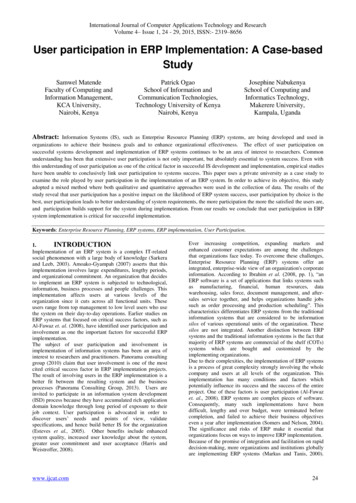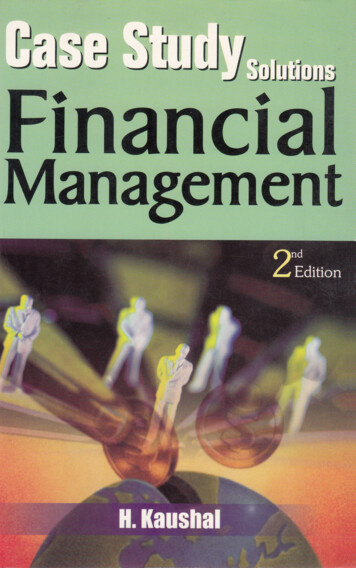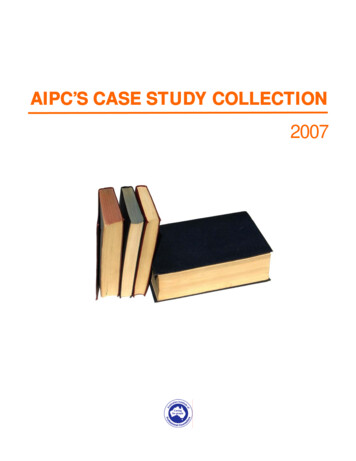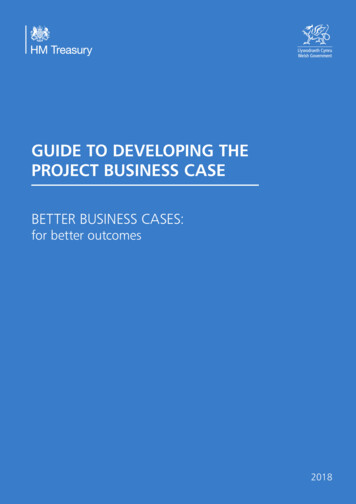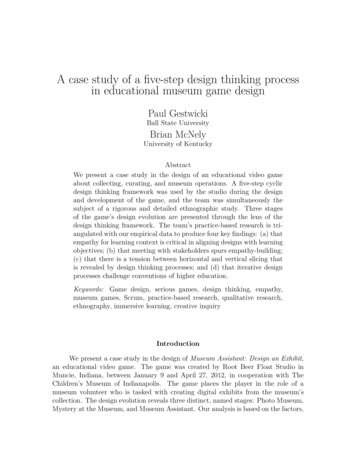
Transcription
A case study of a five-step design thinking processin educational museum game designPaul GestwickiBall State UniversityBrian McNelyUniversity of KentuckyAbstractWe present a case study in the design of an educational video gameabout collecting, curating, and museum operations. A five-step cyclicdesign thinking framework was used by the studio during the designand development of the game, and the team was simultaneously thesubject of a rigorous and detailed ethnographic study. Three stagesof the game’s design evolution are presented through the lens of thedesign thinking framework. The team’s practice-based research is triangulated with our empirical data to produce four key findings: (a) thatempathy for learning context is critical in aligning designs with learningobjectives; (b) that meeting with stakeholders spurs empathy-building;(c) that there is a tension between horizontal and vertical slicing thatis revealed by design thinking processes; and (d) that iterative designprocesses challenge conventions of higher education.Keywords: Game design, serious games, design thinking, empathy,museum games, Scrum, practice-based research, qualitative research,ethnography, immersive learning, creative inquiryIntroductionWe present a case study in the design of Museum Assistant: Design an Exhibit,an educational video game. The game was created by Root Beer Float Studio inMuncie, Indiana, between January 9 and April 27, 2012, in cooperation with TheChildren’s Museum of Indianapolis. The game places the player in the role of amuseum volunteer who is tasked with creating digital exhibits from the museum’scollection. The design evolution reveals three distinct, named stages: Photo Museum,Mystery at the Museum, and Museum Assistant. Our analysis is based on the factors,
DESIGN THINKING IN MUSEUM GAME DESIGNprocesses, and people that influenced these stages, leading to four key findings relevantto serious game design and development.The studio employed a five-step iterative design thinking framework. Designthinking provides a human-centered view of technological artifact design and is therefore an appropriate tool for serious game design. The specific design thinking framework used at Root Beer Float Studio gives careful attention to the qualities of endusers and the utility of the system. The studio’s application of the framework constitutes a practice-based evaluation, one that is held to high levels of rigor in accordancewith the characteristics of practice-based research (Biggs & Büchler, 2007). The findings we describe in this paper are grounded in empirical data gathered through aconcurrent ethnographic study of the lived experience of studio members and theirenvironment.It is significant that Root Beer Float Studio was comprised entirely of undergraduate students who collaborated in a full-time work environment; further detailsof this educational environment are provided in the study context section below. Thisenvironment exemplifies immersive learning, a high-impact pedagogical and curricular practice that provides important contextualization for this work (Gestwicki &Morris, 2012).A review of influential perspectives on design thinking provides justificationfor the studio’s approach, which is necessary in order to form a bridge to the gamedesign literature. We then provide more details on the studio, including salient characteristics about studio members, the work environment, and the project goals. Wealso provide details about our empirical methodology and methods, which serves tocontextualize our findings and conclusions.Design ThinkingDefinition and historyThe phrase “design thinking” was popularized by Rowe (1991) to refer to theways in which designers approach design problems, although design researchers havebeen studying the process for decades (Schon, 1983; Simon, 1969, for example). Incontemporary use, the term refers to both conventional design domains as well as indifferent contexts such as business (Brown, 2009; R. L. Martin, 2009) and computing (Brooks, 2010). Despite such disparate uses and application, design thinking canbe seen as a grounding framework for multidisciplinary teams to communicate andto coordinate activity (Lindberg et al., 2010).Dorst (2011) articulates how a core element of expert design is framing—dealingwith the paradoxes that arise from conflicting considerations in order to create value.Framing can be understood as a form of abductive reasoning; that is, it deals withdeveloping hypotheses that could account for situations or observations. In the caseof design problems that do not have closed-form solutions, the designer is dealing withunknowns of what will be designed as well as how it will create the desired value.2
DESIGN THINKING IN MUSEUM GAME DESIGNWe note that these paradoxes arise in game design but are magnified in serious gamedesign; this is because the educational domain provides another axis for conflict.There is not one definitive model for design thinking. Hekkert & van Dijk (2011)presents a process for industrial design based on alternating deconstruction and reconstruction. Aspelund (2006) presents a seven step sequential model to design that isolates design from production issues. Brown (2008, p.88–89) presents a nonlinear process with three interconnected phases—inspiration, ideation, and implementation—which can be further characterized by smaller-scale steps and reflective questions. Inan articulation specifically for designers of school-based learning experiences, Fierstet al. (2011) describe a five-step model in which iteration is relegated to the finalphase, evolution. A phenomenological perspective is applied by Poulsen & Thøgersen(2011) in their study of the design of a video card game, resulting in a three-phasedesign thinking process consisting of focus, reflect, and reframe; this model reinforcesthe idea that framing is essential to design thinking (Dorst, 2011).The design thinking model presented by Kembel (2009) is notably differentfor its explicit treatment of empathy. His is a five-step cyclic model consisting ofempathy, problem definition, ideation, prototyping, and testing. Empathy arises froma deep understanding of the stakeholders and their needs. It goes beyond merelyinvolving users in a design process and considering their articulated wants and needs:in this model, empathy requires an anthropological approach to understanding usersand their environments (Kelley, 2005; Schell, 2008). When considering the context ofserious game development, this calls to mind the ecological approach, which recognizesthe contextual and embodied natures of knowledge (Gibson & Pick, 2003; Linderoth,2010).Design Thinking and Game DesignAll games teach something through their play (Koster, 2004; McGonigal, 2011),but there is a particular challenge in designing a “serious game” to both entertainand educate. Linderoth (2010) identifies the most difficult aspect to be transfer,that what is learned in one context can be applied in another; transfer is especiallychallenging given the embodied and context-sensitive nature of learning (Gibson &Pick, 2003). Schaller (2011) describes the challenge of museum game design as abalance of entertainment and accuracy, building on the tradition of Roberts (1997).The game design literature provides various formal design models, althoughnone in our survey included explicit treatment of design thinking. Schreiber (2009,Level 2) presents an iterative four-step model for designing analog games and a doublelooped model for digital games. “Design” itself is included as a step in these processes,demonstrating how the term can have confusing, multiple meanings; this sentimentis captured in the famous design aphorism, “Design is to design a design to producea design” (Heskett, 2005, p.3). Fullerton (2008, p.15) presents a four-step iterativeprocess consisting of generating ideas, formalizing ideas, testing ideas, and evaluatingthe results; this is similar to the iterative design process consisting of “prototyping,3
DESIGN THINKING IN MUSEUM GAME DESIGNFigure 1 . Five-step design thinking processplay testing, evaluation, and refinement” presented by Salen & Zimmerman (2004,p11). McGuire & Jenkins (2009) do not provide an explicit iterative process, butthey do encourage building prototypes, the first by at least a quarter through theproject schedule. A useful summary of prototyping processes was recently presentedby Eladhari & Ollila (2012).The design thinking process studied and employed by our participants was basedon Kembel (2009), and an overview of the process is shown in Figure 1. One beginswith empathy for the stakeholders, a group that includes both the players as well asinternal and external agencies; in our study, the university and the studio’s communitypartner were included in consideration as stakeholders (the specific details of whichare described in more detail below). This leads to identification of actual designproblems. Ideation is the seeking of potential solutions to the identified problems.These solutions are built and then tested. The link from test back to empathy iscritical for our study, as will be explained below.Study ContextIn this section, we describe the confluence of people, places, and institutionsthat we studied. This serves to contextualize both our methods and the ethnographicstudy of design history that follows.Immersive LearningOur study took place in a Spring 2012 seminar at the Virginia B. Ball Centerfor Creative Inquiry at Ball State University, a large research university in Muncie,Indiana. The Virginia Ball Center (VBC) sponsors four semester-long seminars eachyear during which teams of students work with a faculty mentor on an interdisciplinaryproblem. Students at the VBC earn fifteen credit-hours for their participation, andthis full-time obligation comprises their entire coursework for one semester. Similarly,the faculty mentor is given a sabbatical-like release from regular duties in order to befully devoted to the seminar.The VBC is housed at the Kitselman Center, a renovated mansion in a residential neighborhood a mile removed from the main university campus. A VBC seminar4
DESIGN THINKING IN MUSEUM GAME DESIGNFigure 2 . Root Beer Float Studio logois designed to be an immersive learning experience (Gestwicki & Morris, 2012; McKillip, 2009; Blackmer, 2008). That is, a VBC seminar: (a) carries academic credit; (b)is student-driven and faculty mentored; (c) generates a product; (d) involves a teamworking on an interdisciplinary problem; (e) involves community partners; (f) focuseson student learning outcomes; and (g) helps students define a career path or otherwisemake connections to industry. We note that immersive learning shares characteristicswith the high-impact learning practices identified by Kuh et al. (2010), particularlywith respect to the engagement of students within a team and with the community.In Spring 2012, Computer Science Prof. Gestwicki led a fifteen-week seminarentitled, “Games, Fun, and Learning,” during which he and the students employedpractice-based research to design and develop an educational computer game. Theteam christened themselves Root Beer Float Studio and worked together from 8AM to4PM, Monday through Friday. The community partner was the Children’s Museum ofIndianapolis—the largest children’s museum in the world—and the expected outcomeof the seminar was a Web-based educational video game.The team consisted of thirteen undergraduates: eight Computer Science majors,one with a second major in Economics; one Music Technology major; one History major; one Visual Communications (Graphic Design) major; one student with majorsin Electronic Art and Animation and Psychology; and one student with majors inTheater and Creative Writing. This distribution of skills matches the heuristics suggested by Cockburn (2007, p.59) for software development teams. More than halfthe team had no prior experience with game design and development. One of theComputer Science majors had taken an honors colloquium on history education gamedesign, and she and five other Computer Science majors had previously worked ontwo major educational game development projects: an American Civil War historygame (Gestwicki & Morris, 2012) and an unreleased historical archaeology simulationgame.5
DESIGN THINKING IN MUSEUM GAME DESIGNFigure 3 . Overview of Scrum. Shaded regions represent human activities and unshaded regions represent the flow of Scrum artifacts. (Figure originally published inGestwicki & Morris (2012).)While most of the semester was spent on design and development activities,there were also guest speakers, reflective writing exercises, discussions, and readinggroups. The team read A Theory of Fun for Game Design (Koster, 2004), during theweeks leading up to the seminar, and several meetings during the semester involveddiscussions based upon this germinal work. Two reading groups within the team wereknown informally as the “Computer Science Group” and the “Arts and HumanitiesGroup.” The former group read, discussed, and applied The Clean Coder (R. C. Martin, 2008), while participants in the latter group read and discussed a variety ofrelevant books during the semester (Dille & Platten, 2008; Gee, 2004; McGonigal,2011, for example).Structure of the fifteen-week seminarThe first week of the semester was used as an introduction to game design. Thefocus of this week was non-electronic games, inspired in part by Costikyan (1998),and some of the activities during the week were adapted from Schreiber (2009) andFullerton (2008). The team also made their first formal visit to the Children’s Museumof Indianapolis to discuss design objectives.The remaining fourteen weeks were organized following industrial best practicesof agile game software development. The team used Scrum (Schwaber & Sutherland,2011) as a team management framework, of which Figure 3 provides an overview.Scrum facilitates an iterative and incremental development methodology and can becharacterized as an agile approach (Beck et al., 2001). Each iteration is called asprint, and the output of each sprint is a potentially shippable product. This product6
DESIGN THINKING IN MUSEUM GAME DESIGNmay be an executable release as shown in Figure 3, but it may also take the formof design documentation, Web sites, physical prototypes, marketing plans, and soon. Root Beer Float Studio used two-week sprints, which is the shortest durationrecommended for game development with Scrum (Keith, 2010, p65). This allowed forthe maximum number of iterations during the semester, which was critical since theduration of the semester—and therefore the deadline of the project—was an inviolableconstraint.Scrum provides a framework to be adapted to local needs (Schwaber & Sutherland, 2011), and so discussion of the team’s particular practices merits brief discussion.Many of our specific practices come from recommendations provided by Keith (2010).Before each sprint, in the role of Product Owner, Gestwicki created and maintaineda prioritized list of user stories (Cohn, 2004, 2006). These user stories were derivedfrom the design work conducted by the team, including prototypes, documentation,team meetings, meetings with the community partner and other content experts. Theteam began each sprint in the Sprint Planning meeting, during which they estimatedthe size of the user stories and committed to completing a subset of them withinthe sprint. The team also articulated the tasks necessary for satisfaction of the userstories and estimated the hours of effort required for each. Gestwicki also served asScrum Master for the project, acting as facilitator for meetings such as the SprintPlanning meeting.Each morning during the sprint, the team met for the eponymous Daily Scrum—a short stand-up meeting during which each person reports on what they had donesince the previous day, what they have planned for the day, and what impedimentsstand in the way. Following Keith (2010), the progress on stories and tasks wasrecorded on a task board (Figure 4 and summarized in the sprint burndown chart (Figure 5). We note that one of the roles of the Scrum Master is to help the team removethe impediments they identify, and hence, the faculty mentor was able to transformimpediments into learning opportunities.At the end of each sprint were two consecutive meetings. During the SprintReview, the team presented and discussed all of the potentially shippable productscreated during the sprint, and Gestwicki—again in the Scrum role of Product Owner—decided whether they adequately satisfied the corresponding user stories. Followingthis meeting was the Sprint Retrospective, during which the team reflected on itsprogress and its process. It is noteworthy that Sprint Retrospective meetings cultivate the metacognition that is necessary for effective reflective practice (Schon, 1983);it is partly because of this that previous researchers (ourselves included) have foundmodified Scrum particularly effective in teaching game design and development (Gestwicki, 2012; Schild et al., 2010).Research MethodsThe empirical data for this study come from the work of an embedded researchteam that conducted an ethnography during the full 15 week semester described7
DESIGN THINKING IN MUSEUM GAME DESIGNFigure 4 . Sample task board created by Root Beer Float Studio to demonstrate itsuse of Scrumabove. Ethnography and other qualitative methodologies have a long and rich history in studies of learning, professional work, and design-related fields such as humancomputer interaction and computer supported cooperative work. Our research protocol, therefore, was influenced by germinal ethnographic and qualitative work in thesefields, especially Lave & Wenger (1991), Wenger (1998), Nardi (1996), Bowker & Star(1999), Spinuzzi (2003), and Lillis (2008), among others. In particular, our researchprotocol was strongly shaped by the analytic framework of activity theory, whichexplores not only intersubjective interactions, but the ways that such interactions aremediated by tools and symbol systems in culturally and historically situated activities and practices (see, for example, Vygotsky (1978), Leont’ev (1981), Cole (1985),Engeström (1990), Engestöm et al. (1999), and Kaptelinin & Nardi (2006)). Beforemoving to our description of participant design experiences, in the remainder of thissection we detail our research questions, data collection and triangulation procedures,and data reduction and analysis procedures.Our overarching research questions focused on the unique affordances of theimmersive learning environment, and our ethnographic methodology gave us a granular, everyday understanding of learning and collaborative design at our research site.At the outset of our exploratory study, we wanted to know, quite simply, what stu-8
DESIGN THINKING IN MUSEUM GAME DESIGNFigure 5 . Sprint 1 Burndown Chart. The straight line shows steady progress, andthe hand-drawn line shows actual progress, measured as totals task hours remaining.dents experience in immersive learning environments, and whether that experiencewas qualitatively different from traditional forms of post-secondary education. Morespecifically, we were interested in the kinds of tool-mediated actions and intersubjective collaborations that could be traced through attention to writing, communication,and design practices during the immersive learning curriculum. Toward that end, thispaper explores follow-on research questions regarding the impact of the five-phase design thinking framework on serious game design and development. In order to explorethis question empirically, a team of four researchers conducted extensive fieldworkwith participants, comprising 135 collective observation hours across 83 separate sitevisits over 15 weeks. (As PI, McNely led data collection efforts; Gestwicki had noaccess to data until after the semester had ended and grades had been reported).Our team collected multiple forms of data across multiple instances with each participant, giving us both a robust qualitative dataset and strong tacit understanding ofeveryday practices from which to base our claims. Our field work resulted in manyindividual data events across six major types:9
DESIGN THINKING IN MUSEUM GAME DESIGNFieldnotes and Analytic Memos: our observations produced nearly 170,000words of fieldnotes that were focused on both individual and collaborative practices, tool mediation, and participant lived experience. Additionally, we produced 24 analytic memos—reflections and syntheses of observed practice duringthe collection period.Audio Recordings: we gathered 45 audio recordings of daily stand-up meetings,sprint reviews, sprint retrospectives, ad hoc collaboration sessions, and impromptu interviews.Interviews: we conducted three rounds of semi-structured interviews with participants, focusing on how participants viewed their own practices and those ofothers, how they viewed their work in relation to traditional curricula, and howthey used a variety of mediating tools in their everyday practice.Photographs: we collected over 400 photographs during our study; these photographs were primarily used to document ephemeral and ad hoc writing practices.Videos: we collected two videos of stand-up meetings and one video of pairprogramming practices.Artifacts: we collected over 150 participant-produced artifacts, including writtendocuments, design objects, and images.Our data collection efforts afforded well-triangulated insights about participantpractices across multiple data events and through multiple spatiotemporal instances.Discussion of the full dataset is beyond the scope of this paper; instead, we relyprimarily on fieldnotes, analytic memos, photographs, and a subset of semi-structuredinterview responses from each round of interviews (forming 493 paragraph-separatedunits), as detailed in Figure 6.We selected these questions from the broader set of semi-structured interviewsbecause they elicited participant insights that were directly related to issues in developing and executing design thinking dispositions. For example, the rather innocuousquestion from Interview #2—“Tell me about the 3/28 Museum Trip”—is contextuallyrich and nuanced, as we describe below. It was after this meeting with communitypartners that the team’s design practice was brought into full relief; participant perspectives on this event, combined with observational data, yield insights into how ourparticipants negotiated the significant challenges of serious game design in an immersive learning model. Questions about the Scrum project management framework, andabout participant perspectives on design thinking and prototyping, provoked insightsabout the everyday practice of game design and development that were triangulatedacross fieldnotes, photographs, and analytic memos.Following Strauss (1986), we rely on the ethnographic data detailed above toproduce a substantive description of the Root Beer Float Studio participants and their10
DESIGN THINKING IN MUSEUM GAME DESIGNTime Frame Selected Interview QuestionsHow much interaction have you had with community partners to this point?How are you personally using things like the UserInterview #12/22 – 3/1Stories and other organizational notes (burndownchart, etc.)?Is there anything particularly challenging or frustrating at this point?We asked about Scrum in our last interview; doInterview #24/2 – 4/6you have any new thoughts about Scrum as amethodology?Tell me about the 3/28 Museum trip.Give me your current perspective on design thinking, iterative design, and prototyping.Interview #34/30 – 5/3If you were to do this all over again, what wouldyou do differently, if anything?Figure 6 . Subset of semi-structured interview questionsexperience as game designers. We discuss our observational data through 15 weeks ofdesign—through everyday ideation, paper and digital prototyping, playtesting, anditeration of the prototype that would eventually become the studio’s shipped game.Fifteen Weeks of DesignThe team met with The Children’s Museum during the first week of thesemester, and a result of this meeting was a list of six potential educational gametopics. During the first sprint, the team created dozens of prototypes in order tonarrow the design space. The second sprint was spent creating high-quality physicalprototypes of the three most viable games from the previous iteration, and at the endof the sprint, one of these was selected for production. The game that was ultimatelyshipped was based on a design from the first sprint that was carried through the second. This design can be characterized by three phases of evolution that correspond tothe three working titles of the prototypes: Photo Museum, Mystery at the Museum,and Museum Assistant. In the remainder of this section, we explore the evolutionof this design through the semester, tracing the prototypes and processes that led tothe final product. We recognize the complex, sociocultural, recursive, and iterativenature of design and do not mean to imply that the design followed a strictly linearpath; however, attention to such nuances is beyond the scope of this paper.Figure 7 provides an overview of the game mechanics that were incorporatedinto the design’s three primary evolutionary stages. The salient features of eachof these prototypes are described in turn below, with special attention paid to therelevant design thinking process phases.11
DESIGN THINKING IN MUSEUM GAME DESIGN12ticket t challengesabstract spaceFeaturemuseum like spacevariable boardfixed boardmultiple endingssingle endinghealth/livesheart loss penaltyheart gain rewardcategory challenges1234567SprintFigure 7 . Selected game mechanics that varied during development. Vertical bluelines represent formal playtesting with end-users, red lines with the community partner.
DESIGN THINKING IN MUSEUM GAME DESIGNArtifactHistory ScienceMicroscope02Lincoln’s Hat31Blown glass01T. Rex Skeleton33Figure 8 . Sample artifacts from Photo Museum13Art0030Sprint 1: Photo MuseumDuring the first sprint, student designers created Photo Museum, a prototypein which the player explores a museum, using a camera to take pictures of artifactson display. This ended up as one of the three prototypes that was selected to carryto the next sprint.Taking photographs of artifacts framed the core gameplay experience. Certainartifacts were quantified by history, art, and science scores. When photographed in thegame, some such artifacts were added directly to the player’s inventory, while othersinitiated challenges: these were overcome by playing previously collected photographswhose total history, art, and science scores exceeded the respective values of thechallenge artifact. Upon successful completion of such a challenge, a photograph ofthe new artifact was added to the player’s inventory, and hence the game featuredmonotonically increasing challenge difficulty. Figure 8 provides an example of gameartifacts; a player facing the T. Rex Skeleton challenge could play photos of the otherthree artifacts to overcome it. In the process, the player would earn “tickets,” whichcould be redeemed for increased attributes or TF2-style hats (Valve Corporation,2007). The designer identified Betrayal at House on the Hill (Daviau et al., 2004) andPokémon Snap (HAL Laboratory, 1999) as primary inspirations for this prototype.As in Betrayal, Photo Museum required the player to draw randomly-selected tilesand arrange them to create the play area; as in Pokémon Snap, the player had acamera with which new collectibles were acquired, and managing these formed thecore of the gameplay.The design bears structural and aesthetic similarity to its inspirations. Playtesting was strictly internal at this stage of our study, and so the team members themselves had to act as both designers and user surrogates. It was not feasible for participants to work with real end-users at this point in the project, but the danger ofbasing decisions on user surrogates is well-known (see Constantine & Lockwood, 1999,for example) and was exacerbated by the team’s inexperience. From the lens of ourdesign thinking framework, we can see that the team found it challenging to balanceempathy-building among the various project stakeholders. Early in the process, thedesigner was primarily considering end-users and our community partner, but aftereach round of internal playtesting, the influence of the team became more apparent.For example, tickets were introduced in response to internal playtesters’ desires forincreased complexity, but this decision was made without consulting end-users or the
DESIGN THINKING IN MUSEUM GAME DESIGNcommunity partner regarding desired complexity level.Sprints 2–5: Mystery at the MuseumDuring the second sprint, as two other concepts were being realized as highfidelity physical prototypes, a small team of designers reshaped Photo Museum intoMystery at the Museum (MatM). In this version, the player takes the role of a childwho is invited to an evening event at a children’s museum. Upon arrival, the childis greeted by a camera-dwelling spirit who informs the player that the museum ishaunted. A three-act dramatic structure is used in which the first act consists of theintroduction and embedded tutorial, the second act comprises an exploration of themuseum while overcoming small challenges, and the third act consists of a granderchallenge and dénouement.Whereas Photo Museum artifacts each had numeric history, art, and scienceratings, the artifacts in MatM had a single integer value—knowledge power (KP)—an abstraction of the cultural and scientific importance of the artifact. This designdecision sparked intense debate within the team, the suspicion being that young players would build inappropriately quantified mental models of artifact
Mystery at the Museum, and Museum Assistant. Our analysis is based on the factors, DESIGN THINKING IN MUSEUM GAME DESIGN 2 processes, and people that influenced these stages, leading to four key findings relevant . This serves to contextualize both our methods and the ethnographic





